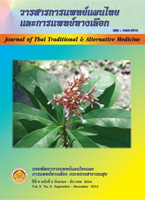DNA Fingerprinting of Derris scandens Benth. from Callus and Different Locations
Main Article Content
Abstract
Twenty samples of Derris scandens Benth., 19 of which were collected from different provinces and one which was from a callus cultured on media formulation 43+C1, underwent morphological study, DNA fingerprint analysis, and TLC fingerprint analysis. Morphological study of the 19 samples showed no difference in characteristics except for the diameter of the stems; the largest was the sample from Phitsanulok (6 cm) and the smallest was the sample from Lop Buri (1.7 cm). However, they were in the same subgroup 2.2, which indicated that the diameter of stems may depend on the age, climate, zone, water and soil where the plant originates.
Analysis of the DNA fingerprint of D. scandens by Winboot program indicated that it was divided into 3 groups. Group 1 was further divided into subgroups 1.1 and 1.2. Those in subgroup 1.1 were from Phetchaburi (Khaokrapook), Prachuap Kiri Khan (Saovapha), Sa Kaeo, Nakhon Pathom (SL) and callus. Those in subgroups 1.2 were from Nonthaburi, Rayong, Chanthaburi. Group 2 was further divided into subgroups 2.1 and 2.2. Those in subgroup 2.1 were from Khon Kean, Prachuap Kiri Khan (Ao Noi), Nakhon Ratchasima, Phetchaburi (Kladlaung) and Nakhon Nayok. Those in subgroup 2.2 were from Kanchanaburi (Bunwangyen), Phitsanulok, Lop Buri, Nakhon Pathom (KU), Buri Ram and Bangkok. The one in group 3 was from Prachinburi only. TLC fingerprint identification showed that the TLC fingerprint pattern of all samples was similar. The present study gave preliminary results on genetic differences of D. scandens Benth. that could be used to identify different varieties of D. scandens and for future genetic development of the plant.


